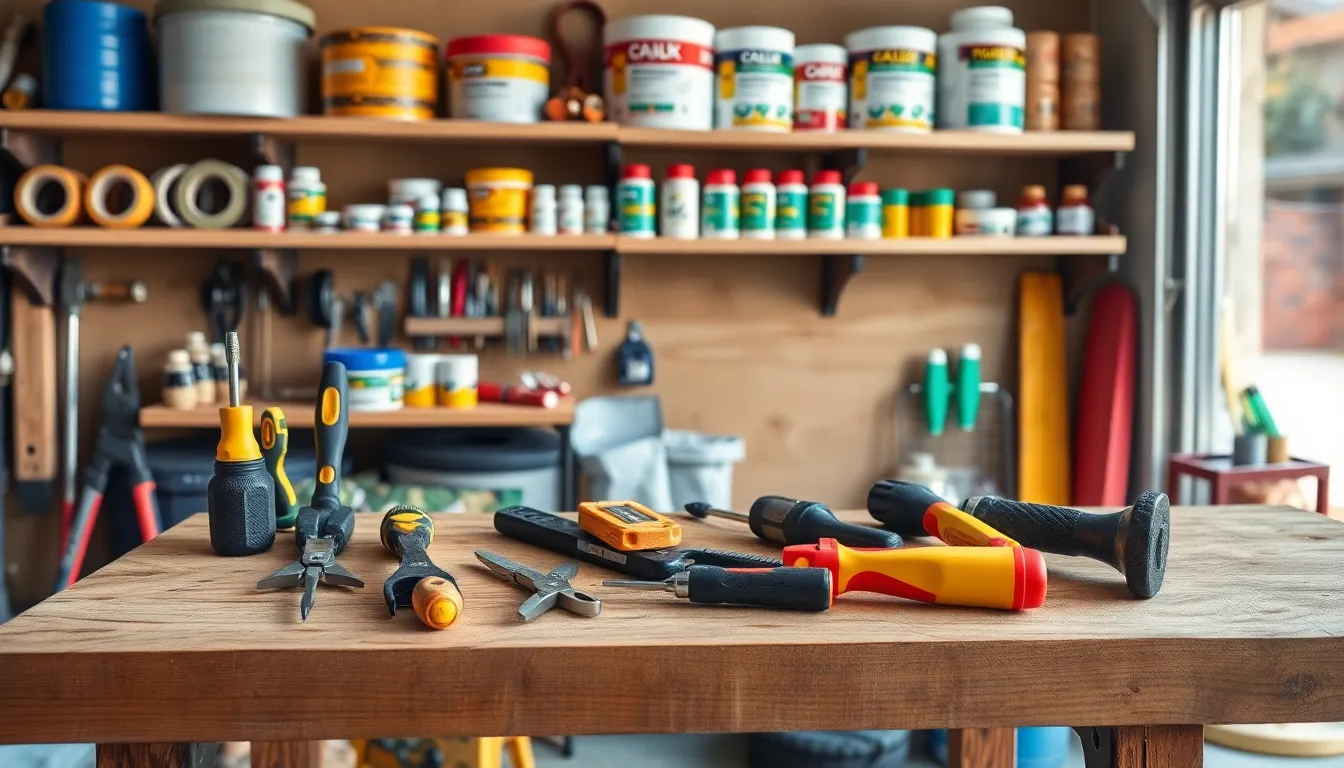Every homeowner knows the struggle: a leaky faucet here, a squeaky door there, and suddenly, your cozy abode feels more like a DIY disaster zone. But fear not! Tackling small home repairs doesn’t require a PhD in plumbing or a degree in carpentry. With just a few tools and a sprinkle of determination, anyone can transform their home from “meh” to magnificent.
Imagine impressing friends with tales of your heroic feats—like fixing that pesky cabinet door that’s been hanging on for dear life. Small repairs not only boost your home’s value but also give you a sense of accomplishment that’s hard to beat. So roll up those sleeves, grab a toolbox, and let’s dive into the world of small home repairs. After all, who needs a handyman when you’ve got the power of YouTube and a can-do attitude?
Table of Contents
ToggleTypes Of Small Home Repairs
Homeowners frequently encounter various small repairs that prevent larger issues. Addressing these tasks enhances the living space and promotes home value.
Plumbing Fixes
Leaky faucets can waste significant water and lead to higher bills. Fixing a faucet typically involves replacing washers or O-rings. Clogged drains also require attention; using a plunger or a drain snake can often resolve the problem. Homeowners might also tackle toilet leaks by adjusting the flapper or tightening connections. Minor plumbing issues often take just a few minutes, but they can save money in the long run.
Electrical Repairs
Squeaky outlets or flickering lights may signal electrical issues worth resolving. Replacing a light switch only requires a screwdriver and a replacement switch. Homeowners can also switch out light bulbs or upgrade to energy-efficient options, reducing energy consumption. Adhering to safety precautions is crucial; turning off the circuit breaker protects against electric shock. Simple repairs can ensure efficient and safe electrical systems throughout the home.
Wall and Ceiling Touch-Ups
Dings and scratches on walls diminish a home’s appearance. Small dents can typically be repaired with spackle, while touch-up paint can blend the fixes seamlessly. Ceiling stains from leaks can benefit from a coat of primer before repainting to prevent future discoloration. Homeowners often find that maintaining walls and ceilings boosts overall aesthetics. Investing time in these minor touch-ups creates a fresh and inviting environment.
Tools And Materials Needed

Home repairs require specific tools and materials to ensure successful outcomes. Knowing what to use simplifies tasks and enhances efficiency.
Essential Tools
A screwdriver set grants versatility for various screws. Pliers aid in gripping and twisting wire effectively. A hammer delivers power for driving nails into wood. Utility knives serve well for precise cuts in different materials. Tape measures ensure accurate measurements, eliminating guesswork. A level provides balance for hanging items straight. Finally, a wrench is useful for tightening or loosening plumbing fixtures.
Recommended Materials
Duct tape offers quick fixes in plumbing and electrical repairs. Caulk seals gaps around windows and doors, enhancing energy efficiency. Patching compounds fill small holes in walls for a smooth finish. Light bulbs ensure bright lighting in any room. Electrical tape safeguards wiring connections from damage. Sandpaper smooths surfaces, preparing them for painting. Lastly, paint touch-up kits match original colors for wall repairs.
DIY vs. Hiring A Professional
Small home repairs often present opportunities for homeowners to save money and take pride in their work. Making the right choice between DIY and hiring a professional can affect both the outcome and value of one’s efforts.
When To DIY
DIY projects work well for tasks that require minimal tools and expertise. Simple fixes like changing light bulbs or clearing clogged drains typically fall into this category. Homeowners can manage these jobs effectively with online tutorials as guidance. Routine maintenance, such as applying caulk or patching minor wall cracks, also suits DIY. Engaging in these projects fosters a sense of ownership and accomplishment. It’s essential to evaluate personal skills and comfort levels with each repair.
When To Call A Professional
Calling a professional becomes crucial when a project involves complex systems. Plumbing repairs like leaky pipes or extensive electrical work necessitate expert knowledge and experience. Major structural repairs often require permits and adherence to safety codes. Homeowners should prioritize safety and consider potential risks in these scenarios. Additionally, intricate tasks like HVAC repairs should only involve certified technicians. Financial implications also play a role; unexpected complications from DIY efforts may lead to higher costs. An expert ensures the job is done right, often saving time in the long run.
Safety Tips For Small Home Repairs
Maintaining safety during small home repairs is essential to prevent accidents. Using the right precautions can help ensure a smooth repair process.
Personal Safety Gear
Safety gear plays a crucial role in protecting oneself while tackling home repairs. Workers should wear safety goggles to shield their eyes from debris. Heavy-duty gloves protect hands from sharp objects and chemicals. A mask helps filter harmful dust and fumes, especially during painting or sanding tasks. Appropriate footwear with slip-resistant soles reduces the risk of falls. When using power tools, ear protection can reduce noise exposure. Maintaining a safety-first mindset significantly reduces injury risk during repairs.
Precautionary Measures
Taking precautionary measures enhances safety and efficiency. Before starting any repair, it’s vital to unplug electrical devices to avoid accidental shocks. Ensuring work areas are well-lit minimizes the chances of missteps. Organizing tools neatly helps prevent trips and falls. Checking for gas leaks and ensuring proper ventilation when working with solvents can prevent health hazards. Homeowners should keep a first aid kit nearby for quick access in case of minor injuries. Establishing a safety checklist before initiating repairs reinforces a thoughtful and secure work environment.
Embracing small home repairs empowers homeowners to take control of their living spaces. By tackling minor issues themselves, they not only save money but also gain valuable skills and confidence. With the right tools and resources at their fingertips, anyone can enhance their home’s functionality and aesthetic appeal.
Safety should always be a priority during these projects. By following guidelines and using proper gear, homeowners can ensure a secure and efficient repair experience. Ultimately, the satisfaction of completing these tasks fosters a deeper connection to one’s home, making every effort worthwhile.


